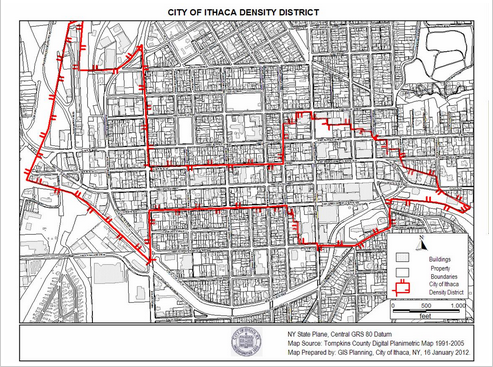This is an opinion column written by Brian Crandall, who runs the blog “Ithacating in Cornell Heights.”
Meet Andre: TCAT’s Youngest Spokesperson
[fvplayer src=”http://vimeo.com/115827899″ loop=”true” mobile=”http://vimeo.com/115827899″]
As the city code dictates, the mayor gives an address to the Common Council, much like the president’s “State of the Union” speech or the governor’s “State of the State.” This year’s “State of the City” speech has a lot of talk about development. But the speech happens to grab my attention for what it alludes to more than what it says.
Among the many passages in the mayor’s speech is this one:
Our CIITAP abatement program has successfully incentivized the kind of development we need but it has caused concern that not enough community benefits are being attained. It’s time to explore reforming the program and adopting an abatement policy that incentivizes growth, benefits all segments of our community, and is consistent with every community in the county.
To that end I will be asking the Tompkins County IDA to work with the City and our partner municipalities to devise a policy that applies to everyone.
Hmm. Quick refresher: CIITAP (Community Investment Incentive Tax Abatement Program) is the program used by the city “to encourage development in the City that would increase jobs, increase the tax base, promote density in the city core, encourage rehabilitation and redevelopment of underutilized sites, and help create a vibrant downtown center.” Meeting certain requirements, a developer can get a break on their taxes, making a project more feasible, and by extension more attractive to banks that give construction loans.
The way it works is like this: if a proposed project is a brownfield site or within a certain part of the city (map below), is 3 floors or restores a historic structure, and costs at least $500,000, then the developer can apply for a 7-year or 10-year tax abatement, providing he or she is up to date on taxes and isn’t letting their other city properties fall apart.
The city holds a public meeting, then decides whether or not to endorse the project, and it goes to the county (TCIDA) for what is normally a rubber stamp approval by that point.

Only a handful of recent projects are in the “Density District”, so by extension, CIITAP is not common. Since CIITAP’s inception in 2012, I know of 5 applications:
-The Carey Building addition
-Harold’s Square
-Hart Hotels (Hotel Ithaca)
-The Ithaca Marriott
-130 E. Clinton (Jason Fane)
Four of those were approved. Formal opposition to the Carey Building and Harold’s Square was virtually non-existent, apart from the usual demand from the local unions that they use union construction labor. There was a little more opposition to the Marriott and the Hotel Ithaca expansions because the developers wouldn’t make the hotels commit to a living wage or commit to build with local union labor.
Then we have 130 East Clinton. Fane was combative and has a bad reputation, so he was already starting off behind the proverbial 8-ball. Without it ever being explicitly stated, I have a feeling the deterioration of the Masonic Temple (and the more recent facade repair) is the reason why that “code compliance” part was recently added to the CIITAP regulations. Fane’s project had endorsement from the city, but was rejected by the county IDA. Most CIITAP and IDA meetings don’t attract more than a handful of attendees. No other project has received a parade of vocal opposition.
If I’m to take a stab at the mayor’s vague passage, my guess is that CIITAP would be reformed in a way to prevent another 130 E. Clinton. The question is: How?
His statement suggests a local union construction labor regulation, but the concern there is that higher costs will make it harder to get construction loans, projects will be mothballed, tax revenue won’t go up and the golden goose gets cooked.
“Being consistent with every community” is another tough one – land is cheaper in Lansing and Ithaca town, and some projects might just opt for more suburban locations, skipping the abatement process and giving their tax revenue to other communities.
Making all projects have a commercial or industrial component is an option (increased jobs), but that will further limit residential supply in an area where housing costs are sharply rising. There is no simple solution here, and without any concrete details, one can only conjecture. Perhaps some of those proposals will be shared at the city’s Planning and Economic Development meeting on the 14th.



